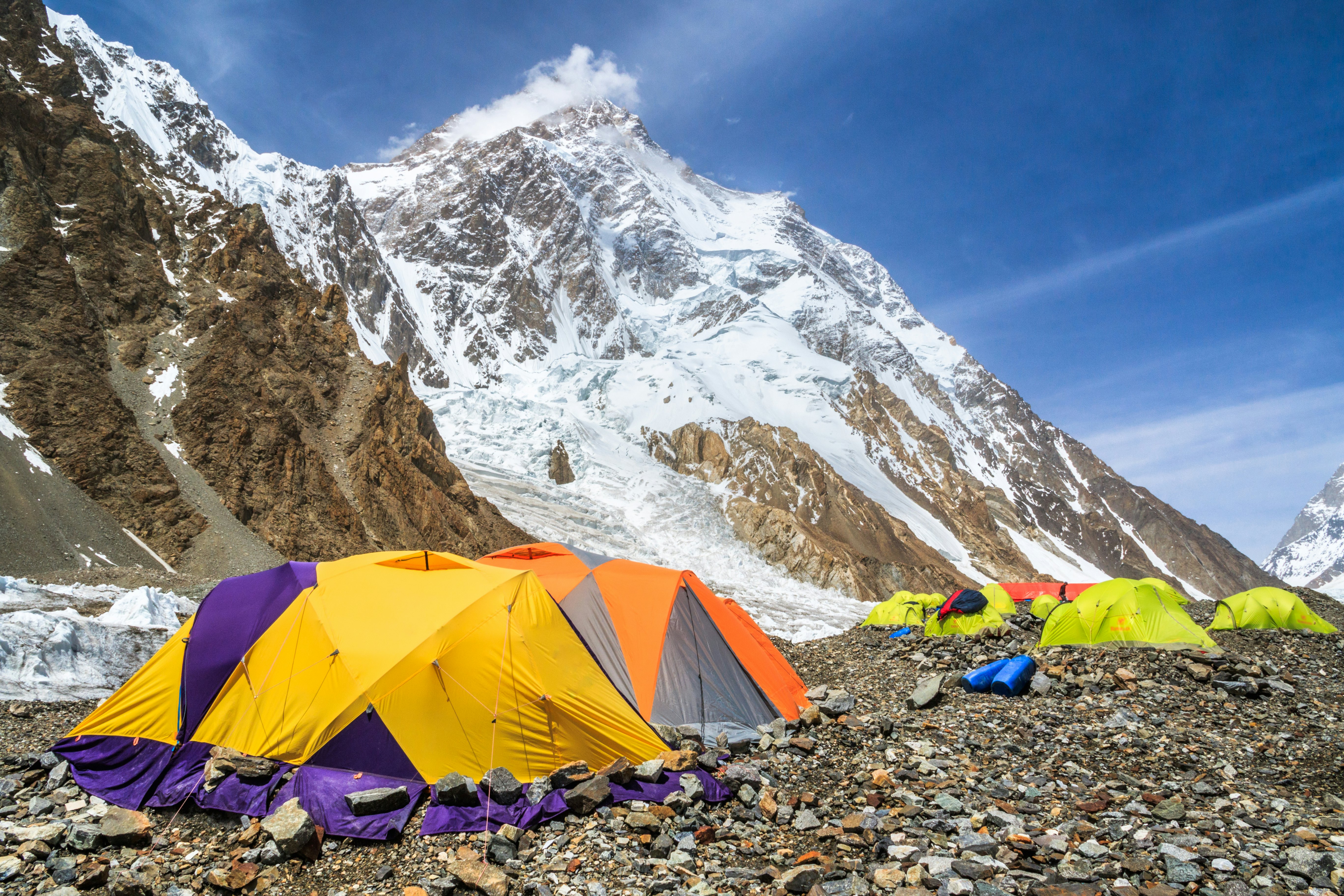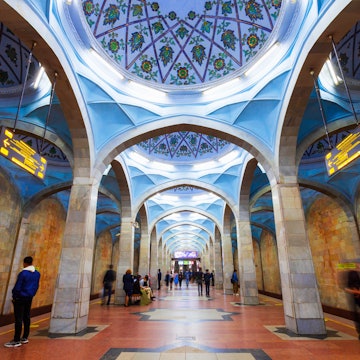

The Karakoram Highway is one of the world's most dramatic driving routes © Koonyongyut / Getty Images
With its incredible range of spectacular scenery, Pakistan offers some truly epic road trips. With a rented car and driver – or your own wheels – you can drive the world’s most dramatic mountain highway, follow historic invasion and trade routes, drift between Sufi shrines and desert forts, or follow the mighty Indus River from the high mountains to the Arabian Sea.
En route, you can stop at roadside dhabas (truckstop restaurants) for tea and kebabs, chat with the drivers of Pakistan’s psychedelic freight trucks, and pause overnight in remote mountain valleys beyond the reach of scheduled transportation. The scope for adventure is almost unlimited.
However, the days of driving an old van through Iran and Afghanistan to Pakistan are long gone. Not many foreign tourists drive their own cars through Pakistan these days, but there are other options. Hardcore cyclists can pedal the Karakoram Highway through some of Asia’s best roadside scenery, and motorcycle hire is also an option for experienced riders.
This said, given the unpredictable traffic and changeable security situation in some parts of the country, hiring a car and driver is still the most common, and safest, way to get around under your own steam. To get you inspired, here are our favorite road trip routes through Pakistan.
1. The Karakoram Highway
Best road trip for world-class mountain scenery
Gilgit–Sost; 180km (112 miles); allow 4 days
Pakistan’s most spectacular road trip is without doubt the stunning Karakoram Highway – often abbreviated to KKH. This rugged route through the far north of the country might just be the most scenic road in Asia, if not the world – it really is that good! The full route runs from just north of Islamabad to Kashgar in China’s politically troubled Xinjiang region, via the 4690m-high Khunjerab Pass, but most travelers focus on the scenic, politically stable and logistically straightforward section between Gilgit and the Chinese border.
From Gilgit, the route follows the Hunza River around hulking Rakaposhi peak (7788m), revealing amazing views of the upper slopes at Nagar and Minapin. From here, it’s a short drive into the fabled Hunza Valley, Pakistan’s answer to Shangri-La. Break the trip here at Karimabad, with its incredible valley views and medieval fort, and budget some time for hiking or the detour up a side valley for views of the epic Hopar Glacier.
Heading north from Hunza, you’ll soon hit the surreal, turquoise waters of Attabad Lake, which formed in 2010 after a massive landslide blocked the valley. The highway threads its way through a series of lakeshore tunnels before reaching more dramatic scenery around Gulmit and Passu. On this section of road, the spectacular witch-hat peaks of the Karakoram Range dominate the skyline, and the massive Passu and Batura glaciers pass within a stone’s throw of the road.
The region’s rickety suspension bridges provide the backdrop for some irresistible selfies, and adventurers can explore the wild side valleys of Shimshal and Chapursan. Most people end their trip at the Pakistani border post in Sost, but it is possible to drive all the way up to the Khunjerab Pass, with some assistance from a local travel agency. It’s an incredible journey to what could be described as the crow’s nest of Asia, and a fitting ending to a simply incredible road trip.
Planning tip: Most travelers start the KKH trip with a flight from Islamabad to Gilgit, to avoid the 19-hour bus ride through the culturally conservative and sometimes politically unstable Kohistan region. To explore the rest of the highway, hire a 4WD vehicle and driver on arrival in Gilgit.

2. A Short Drive in the Hindu Kush
Best drive for visiting remote valleys
Gilgit–Chitral; 400km (250 miles); allow 3–4 days
This wonderful 4WD trip takes you through the beautiful and remote mountain valleys of the Hindu Raj and Hindu Kush mountain ranges to reach the stunning region of Chitral, bordering Afghanistan. Fly from Islamabad and hire a vehicle and driver in Gilgit for this wild trip.
Day one takes you up the Gilgit River past the enticing side valleys (and former independent kingdoms) of Punial, Yasin and Ishkoman. Overnight in Gupis or Phander, both famed for trout fishing, before heading up the beautiful Langar Valley to crest the Shandur Pass at 3810m. Make the trip in July and you can attend the wild, three-day polo festival that attracts hundreds of equestrian fans to this beautiful, wide mountain pass.
A long descent takes you around towering Buni Zom peak and through the Mastuj valley into the Chitral region, past views of massive Tirich Mir (7708m), the highest peak in the Hindu Kush. Take a break in Chitral and visit its famous fort, before making a final drive out to the three Kalash Valleys of Rumbur, Bumboret and Birir, home to the culturally unique, non-Muslim Kalasha people.
Detour: Just west of Gilgit, it’s worth making the 5km trip out to the large, 7th-century standing Buddha carved on a cliff face at Kargah Nala – a relic of pre-Islamic civilizations in Pakistan.
3. Along the Grand Trunk Road
Best road trip for history lovers
Lahore–Peshawar; 520km (323 miles); allow 3 days
For a taste of central Pakistan’s most interesting sights, take a road trip along one of the Subcontinent’s most historic roads – the Grand Trunk Road, founded in the 3rd century BCE. This famous route spans the width of the country, from the Indian border to Afghanistan. The modern highway thunders with heavy traffic, so it’s not a bad idea to hire a car and driver for this trip.
Start with a couple of days in the Mughal city of Lahore, visiting its historic fort, the stunning 17th-century Badshahi Mosque, and the Lahore Museum, where Rudyard Kipling’s father was once curator. Visit the tomb of the Mughal Emperor Jehangir as you drive out of town for bonus Mughal magic.
The first stage of this trip along the Grand Trunk Road crosses the Ravi, Chenab and Jhelum rivers, three of Punjab's eponymous Panj Ab (Five Rivers). It’s worth pausing on the banks of the Jhelum to explore the colossal Rohtas Fort, and then, further west, the 2000-year-old remains of the mighty Buddhist stupa at Mankiala.
Overnight in energetic Rawalpindi or its more orderly twin-city, Islamabad, the Pakistani capital, home to the largest mosque in the country. Finish the day with a fine sunset dinner at Monal in the Margalla Hills overlooking the capital.
An hour’s drive northwest from Rawalpindi is Taxila, the center of the Kushan-era kingdom of Gandhara, where the Indian Emperor Ashoka built a Buddhist university and where some of the most familiar motifs in Buddhist iconography were created. There are plenty of monastery and stupa ruins to raise the pulse of amateur archaeologists, both here and further west along the Grand Trunk at the Gandharan site of Takht-i-Bahi near Mardan.
Passing more Mughal ruins in the city of Hasan Abdal, the Grand Trunk Road finally crosses the mighty Indus River at historic Attock Fort to enter Khyber-Pakhtunkhwa province, where you end the trip at the atmospheric frontier city of Peshawar, famous for its Central Asian-style bazaars, teahouses and mosques. Check the security situation before driving to Peshawar, as there have been issues here in the past.
Detour: Kick off your trip from Lahore with a 25km detour east to the Pakistan/India border at Attari-Wagah to watch burly Pakistani soldiers try to out-stomp, out-scowl and out-salute their Indian counterparts at the fascinating closing-of-the-border ceremony.

4. Along the Indus through Sind & Punjab
Best road trip for cultural immersion
Karachi–Lahore; 1500km (930 miles); allow 8 days
Few foreigners take the time to explore rural Sind or the southern portion of Punjab, but there are some remarkable off-the-beaten track Sufi shrines here, as well as fabulous archaeological sites and spectacular Islamic architecture. Security remains an issue in places, so this is one trip where you’ll benefit from an experienced guide to help you find accommodation and navigate your way through the many police checkposts. A police escort may be required in places such as Multan and Lakarna. Be sure to travel in winter (November to February) to avoid the brutal summer heat.
There are multiple possible routes north from Karachi, but most people plot a route via the ornate Chaukhandi tombs outside of Karachi, the Banbhore archaeological site (from where Islam spread out across Pakistan), the huge Makli necropolis at Thatta, and the fairytale Ranikot Fort. The region’s must-see archaeological site is Moenjodaro, south of Lakarna, the heart of the 5000-year-old Indus Valley civilization. If archaeology is your thing, be sure to also visit the ruins of Harappa further north.
Continue the trip past Kot Diji Fort and the extraordinary 20th-century mosque at Bhong, then enter Punjab and explore the beautiful Sufi shrines of Uch Sharif (the mausoleum of Bibi Jawindi is particularly eye-catching). Explore more sublime Islamic architecture in the form of the stunning tombs at Multan, before finishing the epic trip in the jewel of the Punjab, beautiful Lahore.
5. The Fabulous Fairy Meadows
Best short road trip with mountain views
Raikot Bridge–Fairy Meadows; 17km (11 miles); allow 3 days (including a day of hiking)
Few road trips pack as much scenic punch into such as short distance as the 17km switchback mountain drive from Raikot Bridge, on the Karakoram Highway south of Gilgit, up to the lush alpine pastures of the Fairy Meadows, set at the base of 8126m-high Nanga Parbat, the world’s ninth highest mountain.
Nanga Parbat anchors the far western end of the Himalayas, marking the point where the Himalayas meet the Indus River and the Karakoram and Hindu Kush mountain ranges, and it’s an incredibly scenic spot. The astonishing views of the mountain’s north face are reason enough to visit the Fairy Meadows, but you can use the accommodation here as a base for further day hikes, including up to Nanga Parbat Base Camp. There are few other places where such dramatic high mountain views are so easily accessible.
Planning tip: Local transport operators at Raikot Bridge will insist that you make the trip in one of their 4WD vehicles, and the police may demand that you take an armed guard (a reaction to the deadly terrorist attack at Nanga Parbat Base Camp in 2013). However, you can get to Raikot Bridge by public transport.

6. A Baltistan Loop
Best road trip for mountain majesty
Gilgit–Skardu; 170km (105 miles); allow 5 hours
Northern Pakistan has an abundance of spectacular mountain roads. For an alternative to the Karakoram Highway, consider driving east from the town of Gilgit, along the Indus River on increasingly precarious mountain roads until you reach the climbing gateway town of Skardu. En route, you’ll pass amazing views of the Nanga Parbat and Haramosh peaks, as you trace the dividing line between the Himalayas and the Karakoram range.
Eventually, you’ll enter the fringes of Baltistan, with its traditional mountain villages (we suggest heading to Shigar) and high-altitude deserts. Look out for groups of trekkers and mountaineers heading uphill to the Base Camp for K2 (8849m), the world’s second-highest peak and mountaineering's most challenging ascent.
Adventurers with a fully kitted out 4WD can loop their way back to Gilgit in two days via the 4000m high plateau of Deosai Plains National Park and the remote Astore Valley. You’ll need an experienced local driver to guide you along these remote and often precarious mountain roads.
Driving tips in Pakistan
Self-drive car hire can be arranged in big cities such as Islamabad, but it’s often more expensive than renting a car with a driver, so most people opt for a driver, especially given the challenging traffic conditions in Pakistan. Motorcycle rental is also an option in some cities; try Karakorum Bikers in Gilgit if you plan on exploring Gilgit-Baltistan.
The Karakoram Hwy is paved and in excellent condition, so makes for a particularly fine motorbike or cycle ride. Note that you will need an International Driving Permit to drive in Pakistan. If you drive yourself, drive cautiously and defensively, watching for pedestrians and livestock, and always give way to larger vehicles such as speeding buses and overladen trucks.














